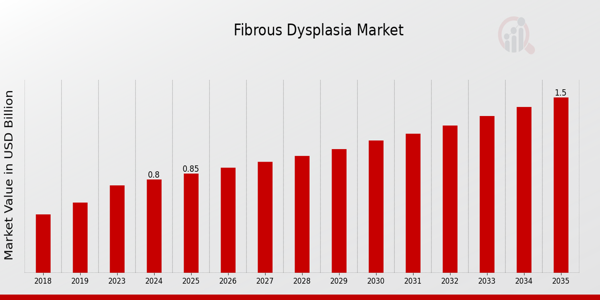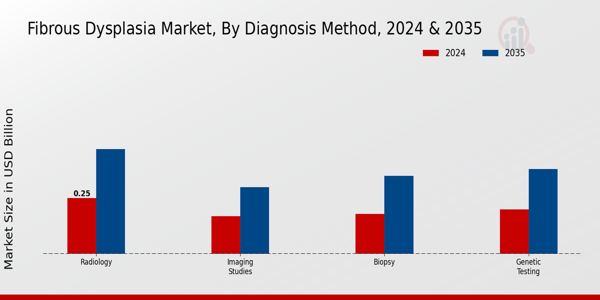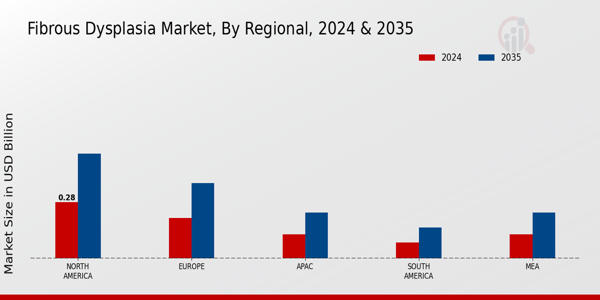Fibrous Dysplasia Market Overview
As per MRFR analysis, the Fibrous Dysplasia Market Size was estimated at 0.75 (USD Billion) in 2023. The Fibrous Dysplasia Market Industry is expected to grow from 0.8(USD Billion) in 2024 to 1.5 (USD Billion) by 2035. The Fibrous Dysplasia Market CAGR (growth rate) is expected to be around 5.89% during the forecast period (2025 - 2035).
Key Fibrous Dysplasia Market Trends Highlighted
The Global Fibrous Dysplasia Market is experiencing notable trends driven by increasing awareness and advancements in treatment options. One of the key market drivers is the rise in the prevalence of fibrous dysplasia combined with the growing demand for effective therapies. As healthcare systems around the world become more focused on rare diseases, there is a push for better diagnosis and management options, leading to innovations in treatment methods. Furthermore, collaboration among global health organizations and pharmaceutical companies has fostered research and development, enhancing patient access to next-generation therapies. Opportunities to be explored within the industry include the potential for developing targeted therapies that address the genetic components of fibrous dysplasia.
By leveraging advancements in biotechnology, companies can work towards personalized medicine solutions that cater to the individual needs of patients. Additionally, expanding educational programs aimed at healthcare providers can improve identification and referral processes for patients with fibrous dysplasia, ultimately boosting patient outcomes. Trends in recent times indicate an increase in clinical trials aimed at testing new drugs and methodologies for managing fibrous dysplasia. Regulatory bodies across different regions are recognizing the importance of this condition, which may lead to expedited approval processes for innovative treatments.As patient advocacy groups become more vocal, they are highlighting the need for research funding and regulatory support, further amplifying market growth potential. Overall, the Global Fibrous Dysplasia Market is witnessing a transformative phase with an enhanced focus on research, personalized therapy, and improved patient care protocols.

Source: Primary Research, Secondary Research, MRFR Database and Analyst Review
Fibrous Dysplasia Market Drivers
Increasing Awareness and Diagnosis of Fibrous Dysplasia
One of the main factors propelling the expansion of the global fibrous dysplasia market industry is the growing awareness of the condition among patients and medical professionals. Awareness and detection rates have increased as a result of educational initiatives and improvements in diagnostic technologies, including genetic testing and sophisticated imaging methods. Rare bone abnormalities, such as fibrous dysplasia, are increasingly being diagnosed, according to the American Academy of Orthopaedic Surgeons. Statistics show that diagnoses have increased by 45% in the last ten years. Patient access to treatment alternatives is improved by this increasing recognition, which eventually propels market expansion. Furthermore, institutions like the National Institutes of Health are actively engaged in research projects meant to improve our understanding of bone abnormalities, which contributes to rising awareness and diagnosis rates throughout the world.
Technological Advancements in Treatment Solutions
Ongoing technological advancements in medical treatments and surgical techniques for fibrous dysplasia are propelling the Global Fibrous Dysplasia Market Industry forward. Innovations in regenerative medicine and minimally invasive surgical methods have resulted in better patient outcomes and reduced recovery times, fostering market growth. According to the Food and Drug Administration, there has been an increase in the approval of novel treatment options, showcasing a significant growth in the number of therapies available for bone-related disorders.The introduction of new treatment modalities by pharmaceutical companies is expected to improve overall patient care and widen market accessibility. Furthermore, established pharmaceutical firms such as Roche and Novartis are investing heavily in Research and Development initiatives aimed at developing targeted therapies, which will support market expansion.
Supportive Government Policies and Funding
Government policies and funding initiatives aimed at fostering research and development in the area of fibrous dysplasia and similar conditions are vital market drivers. Various global government bodies are providing grants and funding opportunities that encourage research and innovative treatments within this niche market. For instance, the European Commission has initiated Horizon Europe, introducing significant funding for health-related research, including musculoskeletal conditions like fibrous dysplasia, amounting to billions annually.Such governmental support not only enhances the focus on this market but also encourages collaboration with educational and research institutions, leading to faster advancements and commercialization of new treatments within the Global Fibrous Dysplasia Market Industry.
Fibrous Dysplasia Market Segment Insights
Fibrous Dysplasia Market Diagnosis Method Insights
The Diagnosis Method segment of the Global Fibrous Dysplasia Market is pivotal in identifying and treating this rare bone condition. In 2024, the segment is poised to contribute significantly to the overall market, which is valued at 0.8 USD Billion. Key components of this segment include Radiology, Biopsy, Genetic Testing, and Imaging Studies, each playing an important role in the diagnostic process. Radiology holds the majority share within this segment, valued at 0.25 USD Billion in 2024, and is anticipated to grow to 0.47 USD Billion by 2035, showcasing its importance as it allows for non-invasive visualization of bone lesions.Biopsy, valued at 0.18 USD Billion in 2024, is crucial for a definitive diagnosis and is predicted to rise to 0.35 USD Billion by 2035, providing crucial tissue samples for analysis that help in understanding the characteristics of fibrous dysplasia.
Genetic Testing, valued at 0.2 USD Billion in 2024 and projected to reach 0.38 USD Billion in 2035, serves as an essential tool for identifying genetic mutations associated with the disease, thus aiding in early diagnosis and management. Lastly, Imaging Studies, which include various techniques like MRI and CT scans, were valued at 0.17 USD Billion in 2024 but are expected to grow to 0.3 USD Billion by 2035, paralleling advancements in technology that enhance the precision of diagnosis in patients.Together, these components reflect a comprehensive approach in the Diagnosis Method segment, addressing the complexities of fibrous dysplasia and facilitating targeted treatment pathways. The continuous advancements in diagnostic capabilities and technology enhance the accuracy of diagnosis, driving growth in the Global Fibrous Dysplasia Market.

Source: Primary Research, Secondary Research, MRFR Database and Analyst Review
Fibrous Dysplasia Market Treatment Type Insights
The Global Fibrous Dysplasia Market focused on Treatment Type is valued at 0.8 billion USD in 2024, reflecting a growing recognition of effective treatment options for this condition. Treatment options are diverse, including Surgery, Medication, Physical Therapy, and Radiation Therapy, each playing a crucial role in patient management. Surgery often serves as a necessary intervention for patients with severe skeletal deformities, while Medication can control symptoms and manage complications associated with fibrous dysplasia. Physical Therapy is essential for enhancing mobility and improving quality of life, making it a significant component of treatment protocols.Additionally, Intraoperative Radiation Therapy finds its application in select cases, contributing to tumor control and alleviating discomfort.
The market benefits from continuous advancements in treatment methodologies and increasing awareness about fibrous dysplasia among healthcare professionals. Market growth is influenced by factors such as the rising incidence of fibrous dysplasia and the development of targeted therapies, alongside a significant shift towards personalized medicine that shapes patient care strategies. Challenges like the limited availability of specialized treatment centers may impact accessibility, fostering opportunities for expanding healthcare infrastructure globally to address this rare bone disorder.Overall, these elements highlight a dynamic landscape in the Global Fibrous Dysplasia Market that is poised for growth and innovation.
Fibrous Dysplasia Market Patient Age Group Insights
The Global Fibrous Dysplasia Market has witnessed notable growth driven by the diverse Patient Age Group comprising Pediatric, Adult, and Geriatric categories. In 2024, the market valuation is reached at 0.8 billion USD. The trends within this market reveal that Pediatric patients are often diagnosed early due to the condition's impact on growth and development, leading to an increased demand for tailored therapies and interventions. Adults tend to experience more advanced stages of fibrous dysplasia, placing additional emphasis on Research and Development to discover effective management strategies.
Meanwhile, the Geriatric segment represents a growing concern as the aging population faces increased health vulnerabilities, which can complicate existing medical conditions. Overall, the Global Fibrous Dysplasia Market segmentation highlights the importance of addressing the distinct needs of each age group, fostering targeted treatment advancements, and improving patient outcomes across the lifespan. This segmentation underscores the dynamics driving market growth amidst rising awareness and the necessity for specialized healthcare solutions, aligning with the broader trends in the healthcare industry.
Fibrous Dysplasia Market Severity Level Insights
The Global Fibrous Dysplasia Market focuses significantly on the Severity Level of the disease, which influences diagnosis, treatment approaches, and overall patient management. In 2024, the market is valued at 0.8 billion USD, reflecting its growing recognition and importance within the healthcare landscape. The Severity Levels are classified into Mild, Moderate, and Severe cases. Mild cases can often go unnoticed, but they still play a crucial role in understanding the diverse manifestations of the disease. Moderate cases require more attentive management, while Severe cases often lead to significant complications, necessitating advanced therapies.
The prevalence of severe cases drives research and development efforts for effective treatments, highlighting the need for clinicians to be well-informed about the condition's trajectory. As the Global Fibrous Dysplasia Market evolves, trends show increasing investments in innovative therapies tailored to these varying severity levels. The ongoing challenges include the need for increased awareness and better diagnostic tools. However, opportunities abound, particularly in developing patient-centric solutions and leveraging advancements in genetic research that can lead to improved outcomes across all severity levels of Fibrous Dysplasia.
Fibrous Dysplasia Market Regional Insights
The Global Fibrous Dysplasia Market showcases a valuable regional segmentation that highlights distinct market dynamics across various areas. In 2024, North America emerges as a significant player with a market valuation of 0.28 USD Billion, expected to increase to 0.519 USD Billion by 2035, attributed to advanced healthcare infrastructure and high prevalence of fibrous dysplasia. Europe follows closely with a valuation of 0.2 USD Billion in 2024, growing to 0.373 USD Billion by 2035, as an aging population drives demand for innovative treatment options.The APAC region, with a valuation of 0.12 USD Billion in 2024, is projected to rise to 0.227 USD Billion by 2035, reflecting increasing healthcare investments and rising awareness of bone disorders. South America, valued at 0.08 USD Billion in 2024, is expected to reach 0.154 USD Billion by 2035, highlighting growing healthcare access issues.
Meanwhile, the MEA region, also valued at 0.12 USD Billion in 2024 with an increase to 0.227 USD Billion by 2035, represents a balanced development influenced by expanding medical facilities. These regional valuations reflect varying degrees of healthcare access, regulatory frameworks, and population demographics, contributing significantly to the Global Fibrous Dysplasia Market revenue and growth trends.The combination of these factors influences the overall market growth and enhances opportunities within the global industry landscape.

Source: Primary Research, Secondary Research, MRFR Database and Analyst Review
Fibrous Dysplasia Market Key Players and Competitive Insights
The Global Fibrous Dysplasia Market is characterized by a diverse and competitive landscape, driven by advancements in medical research and a growing understanding of the condition. Fibrous dysplasia, a rare bony disorder, has prompted various pharmaceutical companies to invest in targeted therapies and treatment modalities. Market dynamics are influenced by the innovation of therapies aimed at managing symptoms and improving the quality of life for affected patients. As a result, competition in the market has intensified, with companies leveraging partnerships, collaborations, and research initiatives to enhance their market presence and address the unique challenges posed by fibrous dysplasia. The landscape showcases numerous players focusing on developing novel treatment approaches, highlighting the need for continuous innovation.
Pfizer has established a significant foothold in the Global Fibrous Dysplasia Market, primarily through its extensive portfolio of research-based medicines and a strong focus on rare diseases. The company's commitment to advancing therapies tailored for conditions like fibrous dysplasia underscores its strengths, including comprehensive scientific expertise and a robust distribution network. Pfizer's strategic collaborations and partnerships with healthcare providers enhance its ability to engage with patients and healthcare professionals, contributing to a more profound market impact. Furthermore, the company's dedication to continuous research and development enables it to remain at the forefront of innovative treatment options, thereby reinforcing its competitive position in the fibrous dysplasia landscape.
Horizon Therapeutics, recognized for its strong focus on specialty medicine, has also made notable contributions to the Global Fibrous Dysplasia Market. The company is known for its innovative approach to developing therapies that address unmet medical needs within rare disorders, including fibrous dysplasia. Horizon Therapeutics has introduced key products that cater to symptomatic treatment and disease management for patients, thereby easing the burden of this condition. Through strategic mergers and acquisitions, the company has been able to broaden its therapeutic offerings while reinforcing its commitment to research and clinical development. Its emphasis on patient support programs and a comprehensive service model further strengthens its position in the global market, making it a vital player in advancing healthcare solutions for fibrous dysplasia.
Key Companies in the Fibrous Dysplasia Market Include
- Pfizer
- Horizon Therapeutics
- Roche
- Novo Nordisk
- Eli Lilly
- Bristol Myers Squibb
- Gilead Sciences
- Novartis
- Regeneron Pharmaceuticals
- Teva Pharmaceuticals
- Merck
- AstraZeneca
- Amgen
- Sanofi
Fibrous Dysplasia Market Industry Developments
Recent developments in the Global Fibrous Dysplasia Market highlight concentrated efforts among major pharmaceutical companies such as Pfizer, Horizon Therapeutics, and Roche towards Research and Development of innovative treatments. Eli Lilly and Novartis have also made strides, focusing on potential therapies targeting the rare bone disorder. Significant market appreciation has been noted, with companies leveraging advancements to increase valuations. In terms of mergers and acquisitions, there have been notable movements; in April 2023, Horizon Therapeutics completed the acquisition of a specialized therapeutic agent, enhancing its portfolio for fibrous dysplasia. Gilead Sciences and AstraZeneca are also showing interest in expanding their footprints in this niche market.
Noteworthy regulatory approvals and collaborations have emerged over the past couple of years, notably in May 2022, when Merck announced a partnership aimed at developing new treatment protocols. These factors collectively reflect a thriving market landscape, underscored by increasing investment in innovative solutions aimed at improving patient outcomes and addressing unmet medical needs associated with fibrous dysplasia globally. The ongoing efforts reflect a promising trajectory for companies involved in this specialized segment of the pharmaceutical industry.
Fibrous Dysplasia Market Segmentation Insights
Fibrous Dysplasia Market Diagnosis Method Outlook
Fibrous Dysplasia Market Treatment Type Outlook
- Surgery
- Medication
- Physical Therapy
- Radiation Therapy
Fibrous Dysplasia Market Patient Age Group Outlook
- Pediatric
- Adult
- Geriatric
Fibrous Dysplasia Market Severity Level Outlook
Fibrous Dysplasia Market Regional Outlook
- North America
- Europe
- South America
- Asia Pacific
- Middle East and Africa
| Report Attribute/Metric Source: |
Details |
| MARKET SIZE 2023 |
0.75(USD Billion) |
| MARKET SIZE 2024 |
0.8(USD Billion) |
| MARKET SIZE 2035 |
1.5(USD Billion) |
| COMPOUND ANNUAL GROWTH RATE (CAGR) |
5.89% (2025 - 2035) |
| REPORT COVERAGE |
Revenue Forecast, Competitive Landscape, Growth Factors, and Trends |
| BASE YEAR |
2024 |
| MARKET FORECAST PERIOD |
2025 - 2035 |
| HISTORICAL DATA |
2019 - 2024 |
| MARKET FORECAST UNITS |
USD Billion |
| KEY COMPANIES PROFILED |
Pfizer, Horizon Therapeutics, Roche, Novo Nordisk, Eli Lilly, Bristol Myers Squibb, Gilead Sciences, Novartis, Regeneron Pharmaceuticals, Teva Pharmaceuticals, Merck, AstraZeneca, Amgen, Sanofi |
| SEGMENTS COVERED |
Diagnosis Method, Treatment Type, Patient Age Group, Severity Level, Regional |
| KEY MARKET OPPORTUNITIES |
Increasing prevalence of fibrous dysplasia, Advancements in genetic therapies, Rising awareness and diagnosis, Development of targeted treatments, Growth in patient-centric research |
| KEY MARKET DYNAMICS |
Rising prevalence of fibrous dysplasia, Increasing awareness and diagnosis rates, Growth in targeted therapies, Expanding research funding, Emerging gene therapy options |
| COUNTRIES COVERED |
North America, Europe, APAC, South America, MEA |
Fibrous Dysplasia Market Highlights:
Frequently Asked Questions (FAQ) :
The Global Fibrous Dysplasia Market is expected to be valued at 0.8 USD Billion in 2024.
By 2035, the market is projected to reach 1.5 USD Billion.
The Global Fibrous Dysplasia Market is expected to grow at a CAGR of 5.89% from 2025 to 2035.
North America is expected to have the largest market share, valued at 0.28 USD Billion in 2024.
The European market is expected to grow to approximately 0.373 USD Billion by 2035.
Radiology is expected to reach 0.47 USD Billion and Biopsy 0.35 USD Billion by 2035.
The Genetic Testing segment is valued at 0.2 USD Billion in 2024.
Key competitors in the market include Pfizer, Roche, Eli Lilly, and Novartis, among others.
The APAC region's market is expected to grow from 0.12 USD Billion in 2024 to 0.227 USD Billion by 2035.
The market faces challenges such as varying diagnosis methods, but also opportunities for advancement in treatment and technology.


















